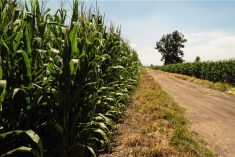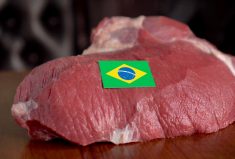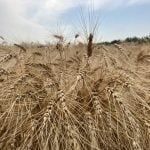Glacier FarmMedia—There’s a rather wide difference between the United States Department of Agriculture and its Brazil counterpart, Companhia Nacional de Abastecimento (Conab) when it comes to Brazil soybeans.
When the USDA released its World Agriculture Supply and Demand Estimates on Apr. 11, the department kept its estimate on Brazil soybean production for 2023/24 at 155 million. Also that day, Conab issued its monthly report, which trimmed its projection to 146.52 million tonnes from the 146.86 million in March.
Early notions of Brazil soybean output exceeding 160 million tonnes were dashed this marketing year due to severe dryness and heat in the country’s northern half, and extremely wet conditions in the southern half. Those widely different conditions made planting very difficult.
Read Also

U.S. livestock: Feeder cattle hit contract highs on tight supply
Chicago | Reuters – All Chicago Mercantile Exchange feeder cattle futures and most live cattle futures hit contract highs on…
Numerous private consultancies steadily reduced their estimates, with several of them predicting a harvest of less than 150 million tonnes. However, the USDA has remained steadfast with its estimates, indicating it believes the crop is much larger than what most others think it will be.
One of those consultancies expecting a Brazil soybean crop at less than 150 million tonnes has been Dr. Michael Cordonnier of Soybean and Corn Advisor Inc. in Hinsdale, Ill. In his most recent calculations, Cordonnier raised his forecast by two million tonnes, expecting the harvest to come in at 147 million tonnes.
As for the wide difference between the USDA and Conab, Cordonnier said it has been the source of a lot of discussions.
“I think part of the problem is the hot and dry weather in Brazil last October and November. Some of the soybeans were replanted several times or even switched to another crop. So what looked like soybeans on the satellite at the start of the season maybe did not end up as soybeans at the end of the season,” Cordonnier stated.
Also he pointed a difference in soybean acre estimates, with Conab at 111.78 million and the USDA believing there’s more.
“The USDA thinks that Conab has not accounted for the expansion of soybean acreage in northeastern Brazil. They may have a point because maybe the farmers are not reporting all their acreage to the Brazilian government for whatever reason. On the other hand, Conab uses satellite technology to estimate acreage just like the USDA, so why is there a difference of almost two million acres of soybean between the two estimates,” said Cordonnier, adding he’s not sure which agency is correct.
A Conab spokesperson said in an email the agency compiles its data through a variety of methods, including several forecasting models, as well as considering the weather conditions of Brazil’s several states, farmer surveys, past data, and crop tours.
“In relation to the various organizations that carry out harvest research, Conab’s principle is to respect the methodologies applied by these entities, understanding that each method has its specific particularities, suited to the availability of human and financial material and other factors that enable execution of the methodology,” the spokesperson wrote.
USDA oilseed analyst Joanna Hitchner explained why the USDA has produced soybean numbers for Brazil higher than those from Conab.
“When estimating Brazilian crops, USDA uses all available data, including CONAB and Brazil’s state agencies. We review CONAB’s estimates because CONAB shows a complete look at the crops in the country. We also use satellite imagery for yield analysis, weather variables, soil moisture maps, and our post reports in Brazil and other publicly available data,” Hitchner stated.
“The USDA shows larger soybean crops than CONAB across several years because we use a balance sheet approach to reconciling the crop. After the marketing year is complete, USDA reconciles its crop estimate with final use data for Brazil using official soybean export data reported by SECEX and crush data reported by Associação Brasileira das Indústrias de Óleos Vegetais (ABIOVE), the widely accepted source for Brazilian crush data,” she added.
— Glen Hallick reports for MarketsFarm from Winnipeg.

















